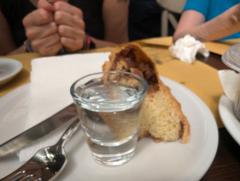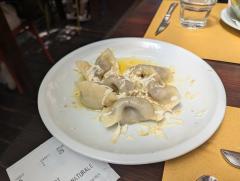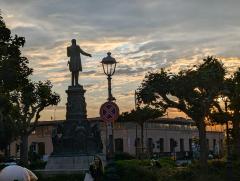 We left Venice on Sunday morning, May 26. It's become our habit to splurge a little to take a Motoscafi water taxi directly from the hotel pier to the airport where we would get a rental car, and drive to Udine & Trieste. From the Hotel Principe it's about three blocks past the train station to the Glass Bridge that crosses the end of the Grand Canal to the Piazza della Repubblica, and from there you can get a taxi or a bus to the airport. On a hot summer morning it's a lot of walking with luggage, and the drive is not pretty. Besides, two years ago I drove from the Piazza della Repubblica and I got a speeding ticket. You could hire a porter to bring your luggage on a cart, but the porters are forbidden from bringing loaded carts over the once-beautiful Glass Bridge, so they have to go a much longer way around.
We left Venice on Sunday morning, May 26. It's become our habit to splurge a little to take a Motoscafi water taxi directly from the hotel pier to the airport where we would get a rental car, and drive to Udine & Trieste. From the Hotel Principe it's about three blocks past the train station to the Glass Bridge that crosses the end of the Grand Canal to the Piazza della Repubblica, and from there you can get a taxi or a bus to the airport. On a hot summer morning it's a lot of walking with luggage, and the drive is not pretty. Besides, two years ago I drove from the Piazza della Repubblica and I got a speeding ticket. You could hire a porter to bring your luggage on a cart, but the porters are forbidden from bringing loaded carts over the once-beautiful Glass Bridge, so they have to go a much longer way around.
 "Experience is what you get when you didn't get what you wanted" and two years ago I got lots of expensive, time-consuming experience. So we took the water taxi and by 9:30 AM we had La Serenissima in the rearview mirror.
"Experience is what you get when you didn't get what you wanted" and two years ago I got lots of expensive, time-consuming experience. So we took the water taxi and by 9:30 AM we had La Serenissima in the rearview mirror.
Our goal of the day was to see Veneto, Friuli-Venezia-Giulia, and Trieste, starting with a drive into northern interior Veneto (the region of which Venice is the capital) to a locavore lunch in Udine (say "OO-dee-nay"), a visit to a Lombard cathedral, and on to Trieste, just a few miles from the Slovenian and Croatian borders. From that far far northeastern launching point we would trace the entire Adriatic and Ionian coasts of Italy, and up the coast of the Tyrrhenian Sea as far as Salerno, the Amalfi Coast, and Pompeii.
 At the airport we got a big fat rental car that could hold the three of us and our luggage, and we made tracks away from that unscenic, unromantic area. Soon enough the scenery became nicer, the countryside grew hillier, and we drove into the little northeastern region of Friuli-Venezia-Giulia. 90 minutes after leaving VCE airport we arrived at the proudly locavore Osteria Ghiacciaia in Udine.
At the airport we got a big fat rental car that could hold the three of us and our luggage, and we made tracks away from that unscenic, unromantic area. Soon enough the scenery became nicer, the countryside grew hillier, and we drove into the little northeastern region of Friuli-Venezia-Giulia. 90 minutes after leaving VCE airport we arrived at the proudly locavore Osteria Ghiacciaia in Udine.
The cuisine of Friuli-Venezia-Giulia is different from anything else in Italy. It is deeply influenced by Austrian cuisine, and by its near-Alpine climate. Two common sweets are illustrative of this: Gubana (shown right) is a sweet spiral pastry filled with nuts, raisins, and grappa, and Presnitz is a phyllo dough pastry filled with a mix of nuts, dried fruits, and spices. Both of these are more akin to the strudels and other viennoiserie that we had enjoyed before getting to Italy.
 This region produces the name-protected Prosciutto di San Daniele, a prosciutto similar the the more well-known (and widely available) Prosciutto di Parma. It's also the home of Prosecco and of Pinot Grigio, indeed some local Pinot Grigios are excellent wines, far superior to the supermarket pinots that we see so commonly here. We drove through acres and acres of vineyards.
This region produces the name-protected Prosciutto di San Daniele, a prosciutto similar the the more well-known (and widely available) Prosciutto di Parma. It's also the home of Prosecco and of Pinot Grigio, indeed some local Pinot Grigios are excellent wines, far superior to the supermarket pinots that we see so commonly here. We drove through acres and acres of vineyards.
Maybe the most iconic dish of the region is Frico, a sort of fried Montasio mountain cheese served hot with soft polenta, shown here.
 Another classic is Cjarsons (say KYAR-sawns), a little stuffed dumpling with a filling of potato and plum, served with melted butter and grated mountain cheese. In addition to the frico, gubana, and cjarsons, we also had cheese plates with local farm and mountain cheeses, country bread with a schmear of Austrian liptauer cheese spread, and house-made pestat with more bread.
Another classic is Cjarsons (say KYAR-sawns), a little stuffed dumpling with a filling of potato and plum, served with melted butter and grated mountain cheese. In addition to the frico, gubana, and cjarsons, we also had cheese plates with local farm and mountain cheeses, country bread with a schmear of Austrian liptauer cheese spread, and house-made pestat with more bread.
Pestat is a creamy spread of herbs and minced vegetables in pork lard, which becomes infused with all those flavors. It sounds strange to us, but it's not so different from butter infused with various seasonings.
 After lunch we drove 25 minutes to the Tempietto Longobardia but the way was blocked by a flea market and then the dreaded ZTL, so we never did get to see the Lombard temple, but I fully expect to get a ticket for driving in the ZTL!
After lunch we drove 25 minutes to the Tempietto Longobardia but the way was blocked by a flea market and then the dreaded ZTL, so we never did get to see the Lombard temple, but I fully expect to get a ticket for driving in the ZTL!
We finally got out of town, only to be stuck for miles behind a Hungarian baseball team; who knew that Hungary has baseball, and that they play away games as far as Italy, two country borders away? This whole episode was kind of funny and it was nice seeing all the acres of vineyards, but it really wasted a lot of our good afternoon time.
 So we drove another 20 minutes to Trieste. Trieste is an interesting city and we didn't have enough time to do it justice. Northeastern Italy was controlled by the Austrian Empire under the Habsburgs from the fall of Napoleon until the end of WWI. The Austrian influence is apparent in the food, but also in the architecture and public monuments, like this one of the well-loved Archduke Maximilian I, who was admiral of the Imperial Navy based out of Trieste, and who built the beautiful white Castello Miramare just north of the city. (He eventually became Emperor of Mexico and came to a bad end.)
So we drove another 20 minutes to Trieste. Trieste is an interesting city and we didn't have enough time to do it justice. Northeastern Italy was controlled by the Austrian Empire under the Habsburgs from the fall of Napoleon until the end of WWI. The Austrian influence is apparent in the food, but also in the architecture and public monuments, like this one of the well-loved Archduke Maximilian I, who was admiral of the Imperial Navy based out of Trieste, and who built the beautiful white Castello Miramare just north of the city. (He eventually became Emperor of Mexico and came to a bad end.)
 Most shops were not open on Sunday. The hotel was a small private affair in a good location but, like many in Italy, it was really some rooms owned by a man with a day job and staffed by his daughter. She was nice, but her ideas of where to get a nice dinner were more than somewhat different from ours... we ended up at a crummy Rossopomodoro pizza joint that turned out to be the worst dining experience of the trip. Worse than that, she forgot that the hot water heater needed to be turned on, and by the time we noticed it on Monday morning she was not yet on duty. It's always best to get a proper hotel with a 24-hour front desk.
Most shops were not open on Sunday. The hotel was a small private affair in a good location but, like many in Italy, it was really some rooms owned by a man with a day job and staffed by his daughter. She was nice, but her ideas of where to get a nice dinner were more than somewhat different from ours... we ended up at a crummy Rossopomodoro pizza joint that turned out to be the worst dining experience of the trip. Worse than that, she forgot that the hot water heater needed to be turned on, and by the time we noticed it on Monday morning she was not yet on duty. It's always best to get a proper hotel with a 24-hour front desk.
But I was able to find the street that we should have gone to. Although the restaurants were closing up, the bars were open and I got to try a Triesta-made Amaro, made with mountain herbs in the Slovenian style. Slovenia is just a few miles east of Trieste, and Croatia is just a few miles to the south, so those influences are also common, under the bigger historical umbrella of the Austrian Empire's influence.
 Trieste has a long history as a coffee port, so its coffee culture is vibrant. There are many ancient caffes and they have their own language for some coffee drinks. I did get to explore that on Monday morning while Lorna and Melissa were getting ready and packing up.
Trieste has a long history as a coffee port, so its coffee culture is vibrant. There are many ancient caffes and they have their own language for some coffee drinks. I did get to explore that on Monday morning while Lorna and Melissa were getting ready and packing up.
There was a classic old coffee place called Mal de Lupo across the piazza from where we were staying. I arrived early and settled in there for most of an hour writing up these notes, but after a while it got pretty crowded. When a woman sat down near me with her two adorable, friendly dogs, I could see that my work was at a dead stop, so I made some happy noises and escaped to another, younger and less-crowded establishment called Antica Tostatura Trieste, right under the hotel, where Lorna and Melissa eventually joined me. I guess I had about 4 cups of coffee that morning!
So we loaded up the car and started the long, eventful journey down the entire Adriatic coast to Santa Maria di Leuca, 750 miles to the south!
